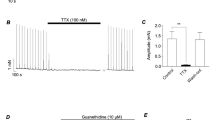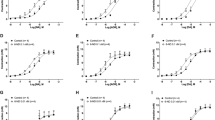Abstract
Release of taurine evoked by electrical stimulation (2700 pulses; 5 Hz; 10 mA unless stated otherwise) and its dependence on noradrenaline and ATP was studied in isolated, perifused rat vas deferens. Outflow of noradrenaline was also measured in some experiments.
The basal outflow of taurine averaged 3.90±0.32 nmol/g tissue per min. Electrical stimulation increased the outflow to about 4 times basal values. The electrically-evoked overflow averaged 128.0±11.7 nmol/ g. An increase in current strength to 40 mA increased the evoked overflow by about 50%. At either current strength, the evoked overflow of taurine (and noradrenaline) was abolished by tetrodotoxin. Ca2+-deprivation blocked the overflow of taurine elicited by 10 mA and increased the overflow elicited by 40 mA pulses (but abolished noradrenaline overflow under either condition). Neither prazosin nor pretreatment of the rats with reserpine reduced electrically-evoked overflow of taurine (although reserpine pretreatment abolished evoked noradrenaline overflow). Tyramine (100 μmol/1; 9 min) caused an overflow of taurine 36% of that caused by electrical stimulation (but an overflow of noradrenaline 3 times higher than that evoked by electrical stimulation). Exogenous noradrenaline (9 min) caused a concentration-dependent overflow of taurine with a maximal effect at 162 μmol/1, amounting to 33% of the electrically-evoked overflow. α,\-Methylene ATP (19 μmol/1) elicited an overflow of taurine that faded despite continued exposure to the drug and amounted to 62% of the response to electrical stimulation. Thirty minutes after the start of application of α, \.-methylene ATP, electrically-evoked overflow of taurine was greatly reduced. Suramin (100 μmol/1) also reduced taurine overflow in response to electrical stimulation.
It is concluded that electrical (neural) stimulation releases taurine in rat vas deferens. The release is mainly postjunctional in origin, secondary to ATP release from sympathetic axon terminals, and a consequence of postjunctional P2x-purinoceptor activation.
Similar content being viewed by others
References
Allcorn RJ, Cunnane TC, Kirkpatrick K (1986) Actions of α,\-methylene ATP and 6-hydroxydopamine on sympathetic neurotransmission in the vas deferens of the guinea-pig, rat and mouse: support for cotransmission. Br J Pharmacol 89: 647–659
Anzano MA, Naewbanij J, Lamb AJ (1978) Simplified two-step column-chromatographic determination of taurine in urine. Clin Chem 24:321–325
Bönisch H, Trendelenburg U (1988) The mechanism of action of indirectly acting sympathomimetic amines. In: Trendelenburg U, Weiner N (eds) Catecholamines II. Springer, Berlin Heidelberg New York, pp 247–277
Bültman R, Starke K (1994) P2-purinoceptor antagonists discriminate three contraction-mediating receptors for ATP in rat vas deferens. Naunyn-Schmiedeberg's Arch Pharmacol 349:74–80
Della Corte L, Bolam JP, Clarke DJ, Parry DM, Smith AD (1990) Sites of [3 H] taurine uptake in the rat substantia nigra in relation to the release of taurine from the striatonigral pathway. Eur J Neurosci 2:50–61
Driessen B, von Kügelgen I, Starke K (1993) Neural ATP release and its α2-adrenoceptor-mediated modulation in guinea-pig vas deferens. Naunyn-Schmiedeberg's Arch Pharmacol 348:358–366
Frank JS, Langer LM, Nudd LM, Seraydarian K (1977) The myocardial cell surface, its histochemistry, and the effect of sialic acid and calcium removal on its structure and cellular ionic exchange. Circ Res 41:702–714
Fredholm BB, Fried G, Hedqvist P (1982) Origin of adenosine released from rat vas deferens by nerve stimulation. Eur J Pharmacol 79:233–243
French AM, Scott NC (1983) Evidence to support the hypothesis that ATP is a cotransmitter in the rat vas deferens. Experientia 39:264–266
Gonçalves J, Guimarães S (1991) Influence of neuronal uptake on pre- and postjunctional effects of α-adrenoceptor agonists in tissues with noradrenaline-ATP cotransmission. Naunyn-Schmiedeberg's Arch Pharmacol 344:532–537
Guimarães S, Osswald W (1969) Adrenergic receptors in the veins of the dog. Eur J Pharmacol 72:133–140
Hanretta AT, Lombardini JB (1987) Is taurine a hypothalamic neurotransmitter?: a model of the differential uptake and compartimentalization of taurine by neuronal and glial cell particles from the rat hypothalamus. Brain Res Rev 12:167–201
Häusser MA, Yung WH, Lacey MG (1992) Taurine and glycine activate the same Cl- conductance in substantia nigra dopamine neurons. Brain Res 571:103–108
Huxtable RJ (1992) Physiological actions of taurine. Physiol Rev 72:101–163
Jacobsen JG, Smith LH (1968) Biochemistry and physiology of taurine and taurine derivates. Physiol Rev 48:424–511
Katsuragi T, Tokunaga T, Ogawa S, Soejima O, Sato C, Furukawa T (1991) Existence of ATP-evoked ATP release system in smooth muscles. J Pharmacol Exp Ther 259:513–518
Kimelberg HK, Bonville DJ, Goderie SK (1993) Use of 51 Cr cell labelling to distinguish between release of radiolabelled amino acids from primary astrocyte cultures being due to efflux or cell damage. Brain Res 622:237–242
Lehmann A, Hamberger A (1984) Inhibition of cholinergic response by taurine in frog isolated skeletal muscle. J Pharm Pharmacol 36:59–61
Lehmann A, Lazarewicz JW, Zeise M (1985) N-Methylaspartate-evoked liberation of taurine and phosphoethanolamine in vivo: site of release. J Neurochem 45:1172–1177
Levitt B, Westfall DP (1982) Factors influencing the release of purines and norepinephrine in the rabbit portal vein. Blood Vessels 19:30–40
Liu QR, Lopezcorcuera B, Nelson H, Mandiyan S, Nelson N (1993) Cloning and expression of a cDNA encoding the transporter of taurine and \-alanine in mouse brain. Proc Natl Acad Sci USA 89:12145–12149
Lombardini JB (1980) Effects of isoproterenol and methoxamine on the contents of taurine in rat tissues. J Pharmacol Exp Ther 213:399–405
Lombardini JB (1993) Spontaneous and evoked release of [3H]taurine from a P2 subcellular fraction of the rat retina. Neurochem Res 18:193–202
Madelian V, Martin DL, Lepore R, Perrone M, Shain W (1985) \-Receptor-stimulated and cyclic adenosine 3′,5′-monophosphate-mediated taurine release from LRM55 glial cells. J Neurosci 5:3154–3160
Mallard N, Marshall R, Sithers A, Spriggs B (1992) Suramin: a selective inhibitor of purinergic neurotransmission in the rat isolated vas deferens. Eur J Pharmacol 220:1–10
Menendez N, Herreras O, Solis JM, Herranz AS, Martin del Rio R (1989) Extracellular taurine increase in rat hippocampus evoked by specific glutamate receptor activation is related to the excitatory potency of glutamate agonists. Neurosci Lett 102:64–69
Morishita H, Sugiyama M, Furukawa T (1983) Inhibition by sulfurcontaining amino acids and GABA of sympathetic neurotransmission in guinea-pig vas deferens. Eur J Pharmacol 95:13–19
Muramatsu N, Kakita K, Kuriyama K (1978) A modulating role of taurine on release of acetylcholine and norepinephrine from neuronal tissue. Jpn J Pharmacol 28:259–268
Oja SS, Kontro P (1989) Release of endogenous taurine and γ-aminobutyric acid from brain slices from the adult and developing mouse. J Neurochem 52:1018–1024
Okamoto K, Kimura H, Sakay Y (1983) Ionic mechanisms of the actions of taurine on cerebellum Purkinje cell dendrites: interdendritic study. Brain Res 260:261–269
Okuyama S, Hashimoto S, Aihara H (1985) Effects on the caudate spindle in rats of taurine and γ-aminobutyric acid (GABA) microinjected into the substantia nigra: involvement of the dopaminergic system. Brain Res 342:366–368
Philibert RA, Rogers KL, Dutton GR (1989) K+ evoked taurine efflux from cerebellar astrocytes: on the roles of Ca2+ and Na+. Neurochem Res 14:43–48
Puka M, Albrecht J, Lazarewicz JW (1992) Noradrenaline- and glutamate-induced taurine release from bulk isolated adult rat astrocytes. Acta Neurobiol Exp 52:31–35
Shain W, Martin DL (1984) Activation of \-adrenergic receptors stimulates taurine release from glial cells. Cell Mol Neurol 4:191–196
Shain W, Martin DL (1990) Uptake and release of taurine — an overview. In: Passantes-Morales H, Martin DL, Shain W, Del Rio RM (eds) Taurine: functional neurochemistry, physiology and cardiology. Wiley-Liss, New York, pp 243–252
Shibanoki S, Kogure M, Sugahara M, Ishikawa K (1993) Effect of systemic administration of N-methyl-D-aspartic acid on extracellular taurine level measured by microdialysis in the hippocampal CA1 field and striatum of rats. J Neurochem 61:1698–1704
Sivakami S, Ganapathy V, Leibach FH, Miyamoto Y (1992) The γ-aminobutyric acid transporter and its interaction with taurine in the apical membrane of the bovine retinal pigment epithelium. Biochem J 283:391–397
Smith KE, Borden LA, Wang CHD, Hartig PR, Brancheck TA, Weinshank RL (1992) Cloning and expression of a high affinity taurine transporter from rat brain. Mol Pharmacol 42:563–569
Soares-da-Silva P (1988) Evidence for dopaminergic co-transmission in dog mesenteric artery. Br J Pharmacol 95:218–224
Vizi ES, Burnstock G (1988) Origin of ATP release in the rat vas deferens: concomitant measurement of [3H]noradrenaline and [14C]ATP. Eur J Pharmacol 158:69–77
von Kugelgen I, Starke K (1991a) Noradrenaline-ATP co-transmission in the sympathetic nervous system. Trends Pharmacol Sci 12:319–324
von Kügelgen I, Starke K (1991b) Release of noradrenaline and ATP by electrical stimulation and nicotine in guinea-pig vas deferens. Naunyn-Schmiedeberg's Arch Pharmacol 344:419–429
Waterfield JC, Turton JA, Scales MDC, Timbrell JA (1991) Taurine, a possible urinary marker of liver damage: a study of taurine excretion in carbon tetrachloride-treated rats. Arch Toxicol 65:548–555
Westfall DP, Stitzel RE, Rowe JN (1978) The postjunctional effects and neural release of purine compounds in the guinea-pig vas deferens. Eur J Pharmacol 50:27–38
Wheler GHT, Klein DC (1980) Taurine release from the pineal gland is stimulated via \-adrenergic mechanism. Brain Res 166:65–74
Wright CE, Tallan HH, Lin YY, Gaull GE (1986) Taurine: biological update. Ann Rev Biochem 55:427–453
Zelikovic I, Chesney RW (1989) Taurine. In: Spiller GA, Scala J (eds) New protective roles for selected nutrients. Current topics in nutrition and diseases. Liss, New York, pp 253–294
Author information
Authors and Affiliations
Rights and permissions
About this article
Cite this article
Queiroz, G., Gonçalves, J., Carvalho, M. et al. Electrically-evoked release of taurine in the rat vas deferens: evidence for a purinoceptor-mediated effect. Naunyn-Schmiedeberg's Arch Pharmacol 351, 60–66 (1995). https://doi.org/10.1007/BF00169065
Received:
Accepted:
Issue Date:
DOI: https://doi.org/10.1007/BF00169065




